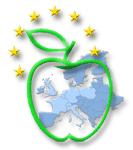Context
The project HiDRAS aims at the identification of the genetic factors controlling apple fruit quality with the objective of increasing the acceptability of disease resistant apples and therefore their diffusion, leading to a remarkable reduction in the use of fungicides. Most of the participants involved in HiDRAS have collaborated in previous EU-funded projects. In particular all the partners, with the exception of the two Polish groups (SGGW and RIPF) have been working together in the DARE (FAIR5-CT97-3898) project and most of them were also involved in the EAGMAP project (AIR-3: CT920473). The long collaboration among the groups and the personal knowledge between the participants is one of the key aspects positively influencing the success of HiDRAS. DARE was focussed on the identification of plant disease resistance and on the study of the epidemiology. Several segregating population have been developed during the course of the project and have been replicated among the participants. Those populations and other material developed in the DARE and EAGMAP projects are used also in HiDRAS. EAGMAP ran from 1993 to 1996 and aimed to increase understanding of the genetics of apple and to identify molecular markers for some traits of horticultural interest (King et al. 1991). It resulted in the European reference molecular marker linkage map for apple (Maliepaard et al. 1997), as well as highly reliable molecular markers for some resistance genes including Vf (Tartarini 1996, Tartarini et al. 1999), which is the most important gene for scab resistance world wide, and Sd, which confers resistance to of the rosy leaf curling aphid Dysaphis devecta (Roche et al. 1997). In addition, the first QTLs and linked molecu-lar markers have been identified for some fruit quality traits including firmness (King et al. 2000; Maliepaard et al. 2001), and juiciness, crispness, sponginess, and taste (King et al. 2000, 2001). Putative QTLs have also been identified for various other traits (acidity, sugar content, juvenility, mildew, King 1997), but the data were either not conclusive or have not yet been fully analyzed. Finally, it contributed to the extension of mapping software for use in outcrossers like apple (Maliepaard et al. 1997).Objectives
The HiDRAS project focusses around 5 main objectives:
1) Identification of the genetic factors controlling apple fruit quality with the objective of increasing the acceptability of disease resistant apples and therefore their diffusion, leading to a remarkable reduction in the use of fungicides.
2) Supply breeders with new and powerful tools, such as molecular markers linked to fruit quality and pathogen resistance QTLs, to improve selection methods, implementing innovative techniques and exploiting the advantages offered by the most recent biotechnological tools.
3) Increase the competitiveness of European growers towards non-European countries that currently occupy a large portion of the European market, especially in late-spring and summer periods when the storability of the European production (with few exceptions) has reached its end. European breeder competitiveness will be improved also by the adoption of molecular tools supplied by this project.
4) Improve consumer acceptance and assess consumer preferences for apples that con-tribute to a healthy diet.
5) Improve the perception of European re-search in genetic area by finding new solu-tions for the preservation of the environment in apple orchards.
Contribution
Phenotypic assessment: Study fruit quality characters of a subset of cultivars defined in the WP1 (Phenotyping assessment) and which are used as parent in the breeding programmes. Ascorbic Acid and flavonoids will be also analysed Consumer tests : Set up of the methodology sensory analysis test in order to point out the link between such analysis data and those obtained by other chemical and physical methods. A hedonic consumer preference will be organized to test a sample of resistant varieties compared with standard ones with the view to determine which quality parameters fit the best with the European consumer demand. Apple data repository : CRA-W is responsible for the coordination work of the European Apple Data Repository, with the help of Part-ner1 (UNIMI – Italy) for the genomic part. The aim is to build a specific apple breeder database to allow breeders to make a much better use of the diversity conserved in many European Genetic Resources collections.Partners
GIANFRANCESCHI Luca (Dr) Università degli Studi di Milano (Italy) Dr. SANSAVINI Silvierio (Prof.) Universita di Bologna (Italy) VAN de WEG Eric (Dr) Plant Research International B.V. (Netherlands) LAURENS François (Dr) Institut National de la Recherche Agronomique (France) GESSLER Cesare (Dr) Plant Pathology, Institute of Integrative Biology (BZ), ETH Zurich (Switzerland) SEYMOUR Graham (Dr) Horticultural Research International (Great Britain) DUNEMANN Frank (Dr) Federal Centre for Breeding Research on Cultivated Plants (Germany) Dr. TOMALA Kazimierz (Prof.) Warsaw Agricultural University (Poland) Dr. ZURAWICZ Edward (Prof.) Research Institute of Pomology and Floriculture (Poland)CRAW off coordinator
GIANFRANCESCHI Luca (Dr) Università degli Studi di Milano Dip. Di Genetica e di Biologia dei Micro-organismi Via Celoria, 26 I-20133 Milano (Italy) Tel : (+39) 02503.15013 Fax : (+39) 02503.15044 E-mail : luca.gianfranceschi@unimi.itFunding
- CE - DG Research - LIFE
- CE - DG Research




